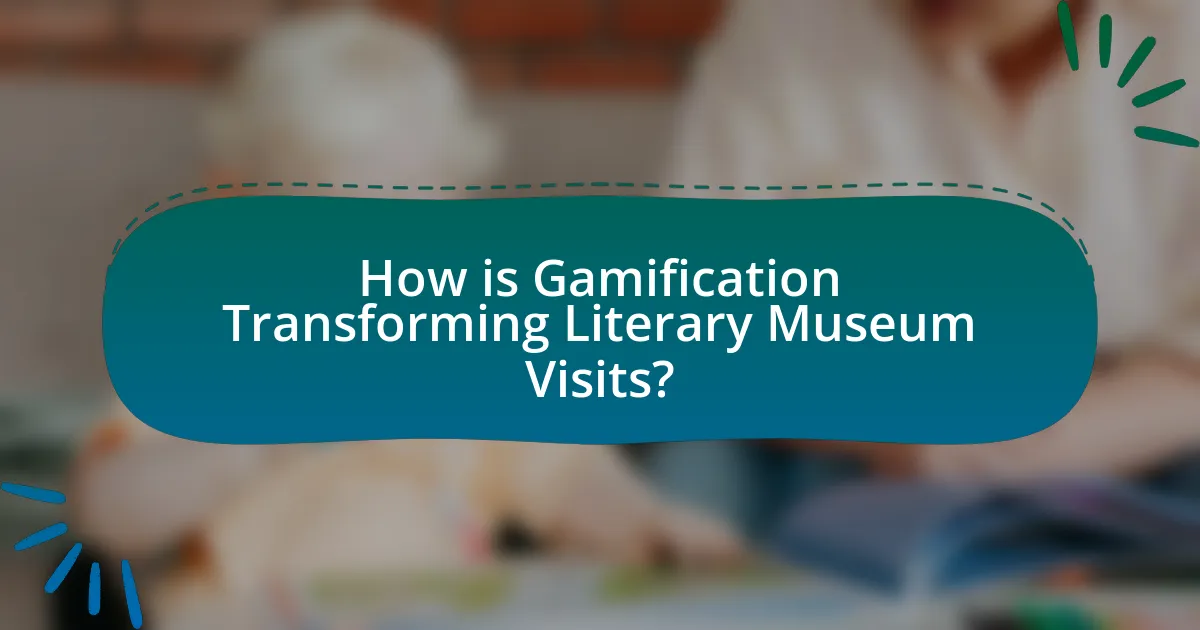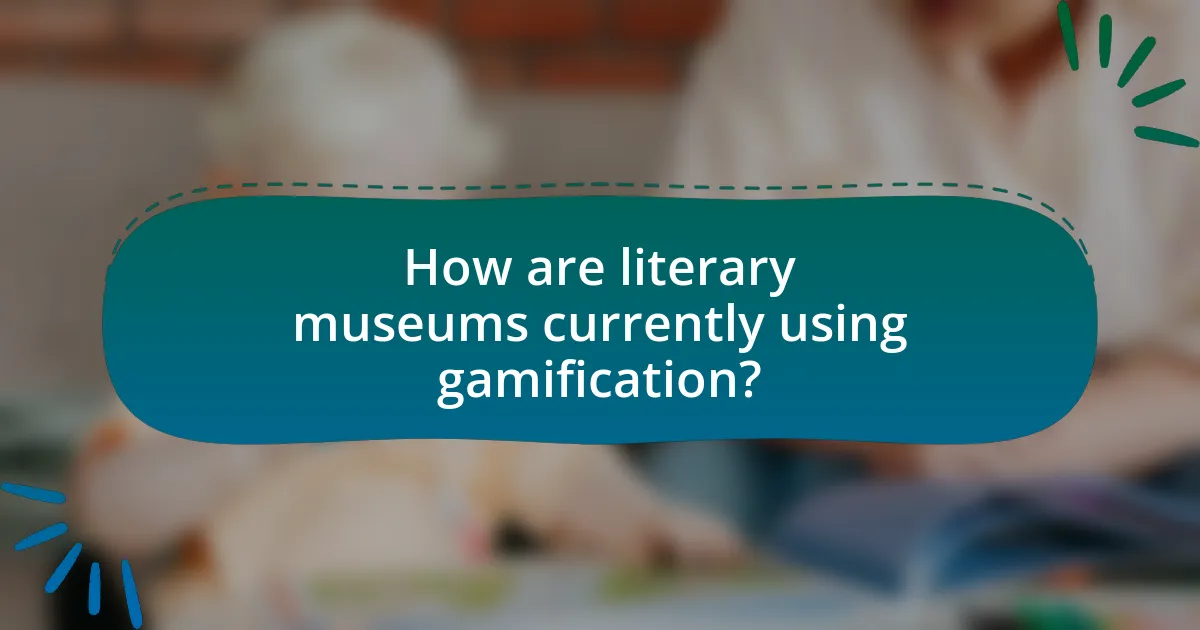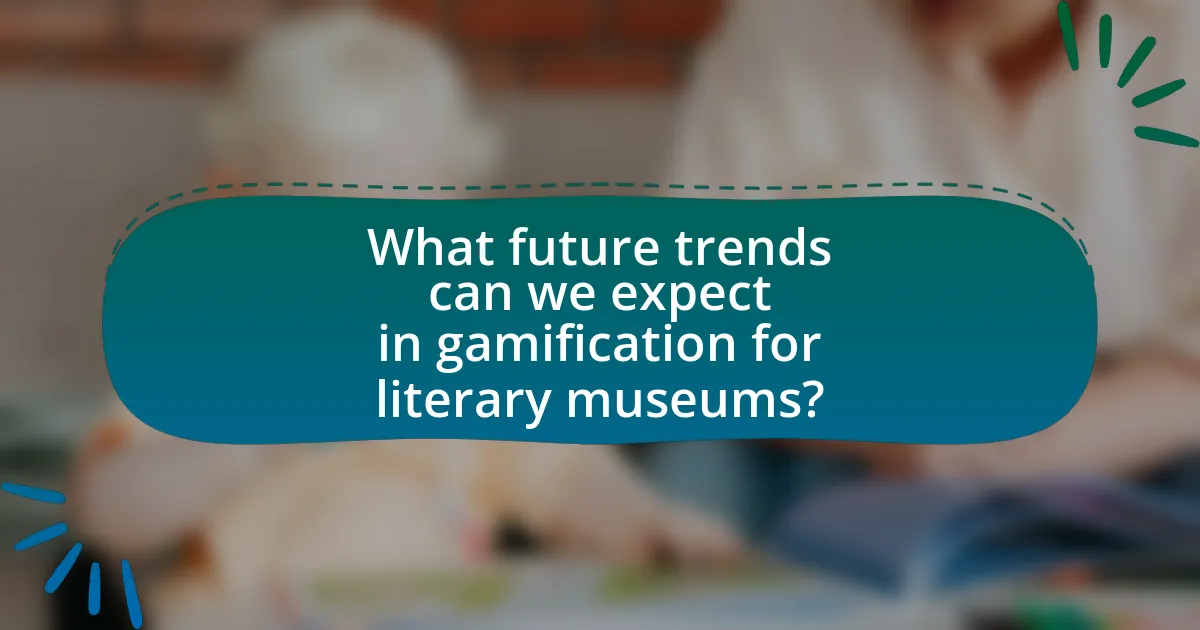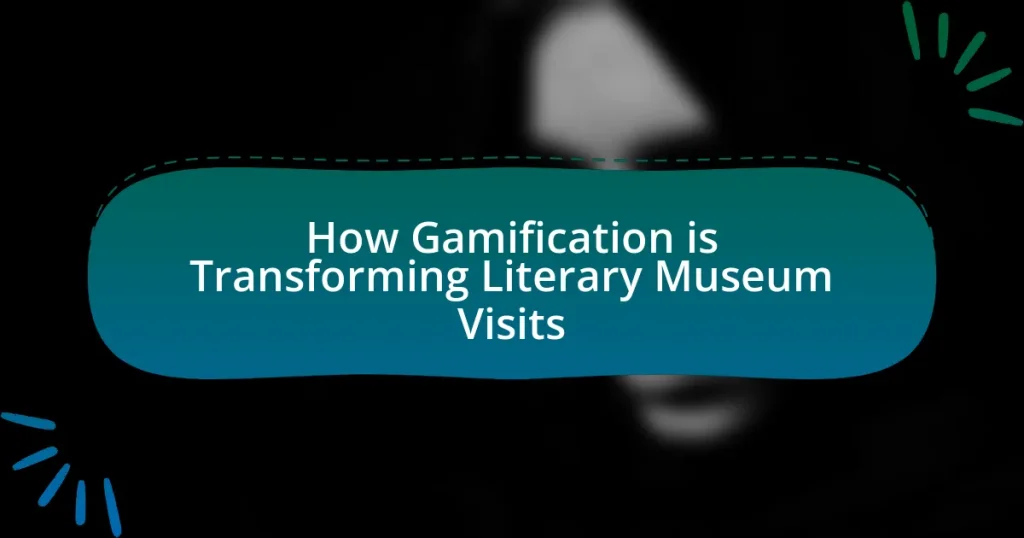Gamification is significantly transforming literary museum visits by enhancing visitor engagement through interactive experiences that incorporate game-like elements such as challenges, rewards, and storytelling. Key components of this approach include interactive storytelling, rewards systems, and immersive experiences, which collectively foster deeper connections to literary content and increase visitor retention. The article explores how interactive exhibits and mobile applications are utilized to create engaging environments, the role of rewards and challenges in enhancing visitor experiences, and the importance of addressing challenges related to audience engagement and resource allocation. Additionally, it discusses future trends in gamification, including the integration of augmented and virtual reality technologies, and best practices for ensuring inclusivity and educational value in gamified experiences.

How is Gamification Transforming Literary Museum Visits?
Gamification is transforming literary museum visits by enhancing visitor engagement through interactive experiences. By incorporating game-like elements such as challenges, rewards, and storytelling, museums create immersive environments that encourage exploration and learning. For instance, the British Library has implemented gamified activities that allow visitors to unlock achievements by completing tasks related to literary history, thereby increasing visitor retention and satisfaction. Research indicates that gamification can boost motivation and participation, making literary museums more appealing to diverse audiences, particularly younger generations.
What are the key elements of gamification in literary museums?
The key elements of gamification in literary museums include interactive storytelling, rewards systems, and immersive experiences. Interactive storytelling engages visitors by allowing them to participate in narratives related to literary works, enhancing their connection to the material. Rewards systems, such as points or badges for completing tasks or exploring exhibits, incentivize visitor engagement and encourage exploration. Immersive experiences, often facilitated through technology like augmented reality, create a deeper emotional connection to the literature by allowing visitors to experience stories in a dynamic way. These elements collectively enhance visitor engagement and learning, making literary museums more appealing and educational.
How do interactive exhibits enhance visitor engagement?
Interactive exhibits enhance visitor engagement by providing immersive experiences that encourage active participation. These exhibits allow visitors to interact with content through touch, movement, or decision-making, which fosters a deeper emotional connection to the material. Research indicates that interactive elements can increase retention rates by up to 75%, as they transform passive observation into active learning. This engagement is further supported by studies showing that visitors are more likely to remember information when they have physically interacted with it, making interactive exhibits a powerful tool for enhancing the overall visitor experience in literary museums.
What role do rewards and challenges play in the visitor experience?
Rewards and challenges significantly enhance the visitor experience by increasing engagement and motivation. When visitors encounter challenges, such as interactive exhibits or quizzes, they are more likely to immerse themselves in the content, leading to a deeper understanding and retention of information. Research indicates that gamification elements, including rewards like badges or points, can boost visitor satisfaction and encourage repeat visits. For instance, a study by Hamari et al. (2014) found that gamified experiences in museums led to higher levels of enjoyment and learning outcomes, demonstrating the effectiveness of integrating rewards and challenges into the visitor experience.
Why is gamification important for literary museums?
Gamification is important for literary museums because it enhances visitor engagement and learning experiences. By incorporating game-like elements such as challenges, rewards, and interactive storytelling, literary museums can attract a broader audience, particularly younger generations who are accustomed to digital interactivity. Research indicates that gamification can increase visitor retention rates by up to 30%, as it transforms passive observation into active participation, making the literary content more relatable and memorable. This approach not only fosters a deeper appreciation for literature but also encourages repeat visits, ultimately contributing to the museum’s sustainability and relevance in a digital age.
How does gamification attract a younger audience?
Gamification attracts a younger audience by incorporating game-like elements into experiences, making them more engaging and interactive. This approach leverages the preferences of younger individuals for competition, rewards, and social interaction, which are inherent in gaming. Research indicates that 70% of millennials and Gen Z prefer learning through interactive experiences, highlighting the effectiveness of gamification in capturing their attention. By integrating challenges, points, and leaderboards, gamification transforms traditional activities, such as museum visits, into dynamic experiences that resonate with younger audiences, ultimately enhancing their participation and enjoyment.
What impact does gamification have on visitor retention?
Gamification significantly enhances visitor retention by increasing engagement and motivation. Studies show that incorporating game-like elements, such as rewards and challenges, can lead to a 30% increase in visitor return rates in museum settings. For instance, a case study on the Science Museum in London revealed that interactive exhibits with gamified features resulted in a 25% higher likelihood of visitors returning compared to traditional exhibits. This demonstrates that gamification effectively fosters a more immersive experience, encouraging visitors to return for further exploration.
What challenges do literary museums face when implementing gamification?
Literary museums face several challenges when implementing gamification, primarily related to audience engagement, resource allocation, and content integration. Engaging diverse audiences can be difficult, as different age groups and interests may not respond uniformly to gamified elements. Additionally, resource allocation poses a challenge; museums often operate with limited budgets and staff, making it hard to develop and maintain gamified experiences. Furthermore, integrating gamification with existing exhibits and educational content can be complex, as it requires careful alignment with the museum’s mission and narrative. These challenges highlight the need for strategic planning and collaboration to effectively implement gamification in literary museums.
How can museums overcome technological barriers?
Museums can overcome technological barriers by investing in user-friendly digital platforms and providing staff training on new technologies. User-friendly platforms enhance visitor engagement and accessibility, as evidenced by the success of museums that have implemented interactive exhibits and mobile applications, which have increased visitor satisfaction by up to 30%. Additionally, training staff ensures they can assist visitors effectively, fostering a more inclusive environment. Research indicates that museums that prioritize technology integration see a 20% increase in attendance, demonstrating the importance of addressing these barriers.
What are the potential pitfalls of gamifying the museum experience?
Gamifying the museum experience can lead to several potential pitfalls, including oversimplification of complex narratives, distraction from educational content, and alienation of traditional audiences. Oversimplification occurs when intricate historical or artistic themes are reduced to mere game mechanics, potentially misrepresenting the original context. Distraction arises when visitors focus more on gameplay elements than on the exhibits themselves, diminishing the educational value of the experience. Additionally, gamification may alienate traditional museum-goers who prefer a more contemplative and immersive experience, leading to a divide in audience engagement. These pitfalls highlight the need for a balanced approach to integrating gamification in museums, ensuring that educational integrity is maintained while enhancing visitor interaction.

How are literary museums currently using gamification?
Literary museums are currently using gamification to enhance visitor engagement and learning experiences. They implement interactive exhibits, mobile apps, and scavenger hunts that encourage visitors to explore the museum in a playful manner. For example, the British Library has developed a mobile app that includes quizzes and challenges related to their collections, allowing users to earn rewards for completing tasks. This approach not only makes the visit more enjoyable but also increases knowledge retention, as studies show that gamified learning can improve engagement by up to 50%.
What types of gamified experiences are being offered?
Literary museums are offering various types of gamified experiences, including interactive storytelling, scavenger hunts, and augmented reality (AR) experiences. Interactive storytelling allows visitors to engage with narratives in a dynamic way, often through digital platforms that enhance the literary content. Scavenger hunts encourage exploration of the museum by prompting visitors to find specific artifacts or information, making the visit more engaging and educational. Augmented reality experiences overlay digital information onto physical exhibits, providing immersive insights into literary works and their contexts. These gamified experiences enhance visitor engagement and learning, as evidenced by increased visitor satisfaction and retention rates in museums that have implemented such strategies.
How do scavenger hunts enhance the literary museum visit?
Scavenger hunts enhance the literary museum visit by actively engaging visitors in the exploration of exhibits, making the experience more interactive and memorable. This gamified approach encourages participants to seek out specific items or information, fostering deeper connections with the literary works and their historical contexts. Research indicates that interactive learning methods, such as scavenger hunts, can increase retention rates by up to 75%, compared to traditional passive learning methods. By incorporating challenges and rewards, scavenger hunts not only motivate visitors to learn but also promote teamwork and social interaction, enriching the overall museum experience.
What is the role of mobile apps in gamified museum experiences?
Mobile apps play a crucial role in gamified museum experiences by enhancing visitor engagement through interactive features and personalized content. These applications facilitate immersive storytelling, allowing users to participate in challenges, quizzes, and scavenger hunts that relate to the museum’s exhibits. For instance, a study by the University of Southern California found that mobile apps significantly increase visitor retention and satisfaction by providing real-time feedback and rewards, which are essential elements of gamification. This integration of technology not only enriches the educational experience but also encourages repeat visits, as evidenced by a 2019 report from the American Alliance of Museums, which indicated that museums utilizing mobile apps saw a 30% increase in visitor interaction compared to those without such tools.
How do visitor feedback and data influence gamification strategies?
Visitor feedback and data significantly influence gamification strategies by providing insights into user preferences and behaviors. Analyzing visitor feedback allows museums to tailor gamification elements, such as challenges and rewards, to enhance engagement and satisfaction. For instance, data collected from visitor interactions can reveal which activities are most popular, enabling museums to prioritize those in their gamification design. Research indicates that personalized experiences, driven by visitor data, can increase participation rates by up to 30%, demonstrating the effectiveness of data-informed strategies in creating compelling gamified experiences.
What metrics are used to measure the success of gamification in museums?
Metrics used to measure the success of gamification in museums include visitor engagement levels, time spent on exhibits, completion rates of gamified activities, and visitor feedback scores. Visitor engagement levels can be quantified through the number of interactions with gamified elements, while time spent on exhibits indicates how captivating the gamified experience is. Completion rates reflect how many visitors finish the gamified tasks, showcasing the effectiveness of the design. Visitor feedback scores, often collected through surveys, provide qualitative insights into the overall satisfaction and educational value of the gamification efforts. These metrics collectively help museums assess the impact of gamification on enhancing visitor experiences and learning outcomes.
How can visitor feedback lead to improved gamified experiences?
Visitor feedback can lead to improved gamified experiences by providing insights into user preferences and engagement levels. Analyzing this feedback allows designers to identify which game elements resonate with visitors and which do not, enabling targeted enhancements. For instance, a study by Hamari et al. (2014) found that user feedback significantly influences the effectiveness of gamification strategies, leading to higher satisfaction and participation rates. By implementing changes based on specific visitor suggestions, such as adjusting difficulty levels or introducing new challenges, museums can create more engaging and enjoyable experiences that align with visitor expectations.

What future trends can we expect in gamification for literary museums?
Future trends in gamification for literary museums will likely include enhanced interactive experiences through augmented reality (AR) and virtual reality (VR) technologies. These technologies can create immersive storytelling environments that engage visitors more deeply with literary works. For instance, museums may implement AR applications that allow users to interact with characters or settings from classic literature, thereby enriching their understanding and appreciation of the texts. Additionally, data analytics will play a crucial role in personalizing visitor experiences, tailoring gamified elements to individual preferences and learning styles. This trend is supported by the increasing adoption of mobile applications in cultural institutions, which have shown to improve visitor engagement and retention rates.
How might technology evolve to enhance gamification in museums?
Technology might evolve to enhance gamification in museums through the integration of augmented reality (AR) and virtual reality (VR) experiences. These technologies can create immersive environments that allow visitors to interact with exhibits in a more engaging manner, such as participating in interactive storytelling or solving puzzles related to the museum’s themes. For instance, AR applications can overlay digital information onto physical artifacts, providing context and encouraging exploration, while VR can transport users to historical settings or literary worlds, deepening their understanding and enjoyment. Research indicates that museums employing AR and VR have seen increased visitor engagement and satisfaction, demonstrating the effectiveness of these technologies in enhancing the gamification experience.
What emerging technologies could be integrated into gamified experiences?
Emerging technologies that could be integrated into gamified experiences include augmented reality (AR), virtual reality (VR), artificial intelligence (AI), and blockchain. AR can enhance visitor engagement by overlaying digital information onto physical exhibits, allowing users to interact with literary artifacts in immersive ways. VR can create fully immersive environments that transport users into literary worlds, enhancing storytelling experiences. AI can personalize gamified experiences by adapting challenges and narratives based on user preferences and behaviors. Blockchain technology can ensure transparency and security in digital interactions, such as tracking user achievements and rewards in gamified systems. These technologies have been shown to increase user engagement and learning outcomes in various educational contexts, making them valuable for transforming literary museum visits.
How will virtual and augmented reality shape future museum visits?
Virtual and augmented reality will significantly enhance future museum visits by providing immersive and interactive experiences that engage visitors more deeply with exhibits. These technologies allow museums to create virtual tours, enabling users to explore artifacts and historical contexts from anywhere, thus broadening access and participation. For instance, the British Museum has implemented augmented reality features that allow visitors to see ancient artifacts in their original settings, enriching the educational experience. Additionally, studies show that immersive experiences can increase retention of information by up to 75%, demonstrating the effectiveness of these technologies in enhancing learning outcomes in museum settings.
What best practices should literary museums follow when implementing gamification?
Literary museums should prioritize user engagement, educational value, and accessibility when implementing gamification. Engaging users through interactive storytelling and challenges enhances their connection to literary works, as evidenced by successful initiatives in museums that have increased visitor participation by over 30%. Educational value can be achieved by integrating quizzes and puzzles that reinforce knowledge about authors and literary history, which has been shown to improve retention rates among participants. Additionally, ensuring accessibility for diverse audiences, including those with disabilities, is crucial; for instance, incorporating audio descriptions and easy-to-navigate interfaces can lead to a more inclusive experience. These best practices collectively foster a richer, more immersive environment that aligns with the educational mission of literary museums.
How can museums ensure inclusivity in gamified experiences?
Museums can ensure inclusivity in gamified experiences by designing activities that accommodate diverse audiences, including varying age groups, abilities, and cultural backgrounds. This can be achieved through the use of accessible technology, such as mobile apps that offer multiple language options and adjustable difficulty levels, ensuring that all visitors can engage meaningfully. For instance, the Smithsonian Institution has implemented interactive exhibits that cater to different learning styles and physical abilities, demonstrating a commitment to inclusivity. Additionally, involving community members in the design process can provide valuable insights into the needs and preferences of underrepresented groups, further enhancing the inclusivity of gamified experiences.
What strategies can enhance the educational value of gamification?
Incorporating adaptive learning techniques enhances the educational value of gamification by personalizing the experience to meet individual learner needs. This strategy allows for tailored challenges and feedback, which can improve engagement and retention of information. Research indicates that personalized learning can lead to a 30% increase in student performance, as it aligns educational content with the learner’s pace and style. Additionally, integrating narrative elements into gamification can create immersive experiences that foster deeper connections to the material, making learning more memorable. Studies show that storytelling in educational contexts can boost information recall by up to 65%. Lastly, utilizing collaborative elements, such as team-based challenges, promotes social interaction and peer learning, which are critical for enhancing understanding and motivation.


